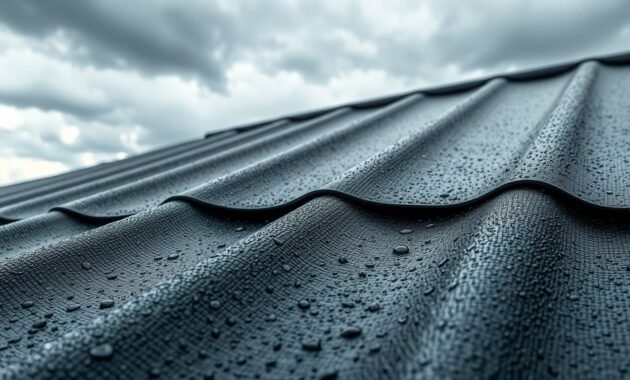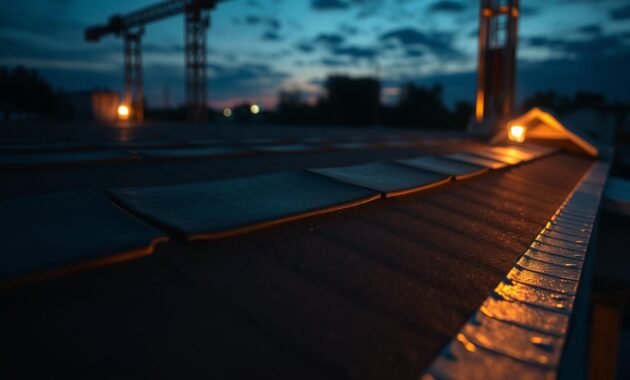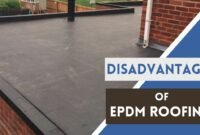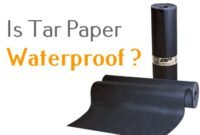Are you tired of leaky roofs and the high cost of professional installations? Many homeowners face problems with traditional roofing. It can be expensive and frustrating.
Rubber roof installation can be a challenge. It may lead to water damage, uneven surfaces, and complex techniques. These issues can seem overwhelming.
But, installing a rubber roof doesn’t have to be hard. With the right preparation and techniques, you can do it yourself. This guide will help you through every step.
It will show you how to create a durable, watertight roof. Your home will be protected for many years.
We’ll cover everything from understanding EPDM materials to mastering application techniques. I’ll break down the process into simple steps. Get ready to make your roofing project a success.
Read also: Install Zinc Strips for Roof Moss
Understanding EPDM Rubber Roofing Materials
EPDM rubber roof technology is a big deal in modern roofing. It’s a favorite among homeowners and contractors. This material changes the game for flat and low-slope roofs.
What Sets EPDM Apart from Traditional Roofing
EPDM membranes are way more durable and long-lasting than old roofing. They can last up to 30 years. Here’s why they’re different:
- Superior weather resistance
- Enhanced flexibility in extreme temperatures
- Minimal maintenance requirements
- Cost-effective long-term solution
EPDM Membrane Thickness Options
EPDM membranes come in standard sizes. They’re usually 10-ft by 50-ft or 10-ft by 100-ft. There are different thicknesses:
- 0.045 inches – Suitable for lightweight applications
- 0.060 inches – Recommended for fully adhered systems
Benefits of Synthetic Rubber Roofing
Choosing an EPDM rubber roof has many perks. It costs between $4.50 to $15 per square foot. This makes it a good choice for those watching their budget. Plus, it’s energy-efficient, thanks to different colors.
| Characteristic | EPDM Roofing Performance |
|---|---|
| Lifespan | Up to 30 years |
| Installation Methods | Fully adhered, ballasted, mechanically fastened |
| Energy Efficiency | Varies by membrane color |
Knowing these key points about EPDM rubber roofing helps you make a smart choice for your next project.
Essential Tools and Materials for Rubber Roof Installation
Getting ready for a rubber roof installation means you need the right tools and materials. I’ve learned from my roof rubber projects that being well-prepared is key. It can make or break your installation.
For a successful rubber roof installation, you’ll need several specialized tools and materials:
- EPDM rubber membrane rolls (10-ft. by 50-ft. or 10-ft. by 100-ft.)
- Heavy-duty scissors for precise cutting
- 9″ roller set for even application
- Mini roller for tight spaces
- EPDM roofing brush for primer application
- Paint roller and tray for deck adhesive
- Brass penny roller for seam pressure
- Water-based deck adhesive
- EPDM primer
The recommended EPDM membrane thickness is 0.060 inches. This thickness offers superior durability for your rubber roof. I suggest investing in quality tools for a professional finish.
Professional tip: For small roof areas, choose a fully adhered installation system. It’s cost-effective and doesn’t need complex equipment. With the right tools and preparation, you can make a rubber roof that lasts up to 50 years.
Remember, the right tool selection is as important as the membrane itself. Each tool is vital for creating a watertight, long-lasting roof surface.
Read also: Flex Seal for Roof: Is It Working Effectively?
Preparing Your Roof Surface for EPDM Installation
Installing an EPDM rubber roof needs careful surface prep. I’ll show you how to get ready for a successful roof fix and avoid water damage.
Before starting your EPDM installation, check and prepare your roof surface. This step is key to avoiding problems with asphalt shingles and keeping your roof in good shape for a long time.
Removing Old Roofing Materials
Removing old roofing is the first step in fixing your roof. Here are some important things to remember:
- Take off all old asphalt shingles
- Scrape off any leftover bitumen
- Look for water damage signs
- Get rid of old materials the right way
Inspecting and Repairing the Roof Deck
Checking the deck well is vital to stop water damage later. Make sure to:
- Look for rot or decay in wood
- Check if the roof deck is strong
- Make sure the surface is even
- Use the right substrate materials (18mm OSB3 or plywood)
Cleaning and Priming the Surface
Getting the surface ready right ensures the EPDM membrane sticks well. Important steps include:
- Make sure the roof is dry
- Clean it well to remove dirt
- Apply the right primer for better sticking
- Check the surface temperature (at least 4°C)
By doing these prep steps, you’ll set up a great base for your EPDM rubber roof. This will help avoid future roof repairs and protect against water damage.
Understanding Weather Conditions for Installation

Installing a roof rubber roof needs careful planning, mainly for weather. The success of your EPDM rubber roof installation depends on temperature and moisture. I’ll help you understand the weather factors that are key for your roofing project.
Temperature is very important for EPDM rubber roof installation. Most makers say to install when it’s above 5°C (41°F). Some products, like GenFlex Seam2Seam™ EPDM SA, can be installed in temperatures as low as 20°F (-7°C). This gives you more options during installation.
- Ideal installation temperature: Above 5°C (41°F)
- Extreme low-temperature installation: Down to 20°F (-7°C) with specific products
- Avoid installation during wet or freezing conditions
When getting ready for your epdm rubber roof installation, think about these weather factors:
- Check local weather forecast for dry conditions
- Ensure no precipitation is expected within 24 hours
- Verify that temperatures will remain stable during installation
Adhesive performance is closely tied to temperature. Water-based adhesives might not bond well below 5°C. For the best results, keep your materials at room temperature (60°F to 80°F) before use. Let them get used to the temperature for 1-4 hours.
Proper planning and understanding weather conditions are key for a long-lasting and effective EPDM rubber roof. Take the time to prepare and choose the right conditions for a successful installation.
Step-by-Step Rubber Roof Installation Guide
Installing an EPDM membrane needs precision and attention to detail. As a DIY enthusiast, I’ll guide you through the key steps. These steps will help you install a rubber roof that will last for decades.
Measuring and Cutting the EPDM Membrane
Getting the measurements right is key when installing a rubber roof. Here are the important steps:
- Measure your roof surface accurately, adding 6 inches for overlap
- Use a sharp utility knife for clean cuts
- Make sure the EPDM membrane is flat before cutting
Applying Adhesive Properly
Applying adhesive correctly is vital for a good rubber roof installation. Make sure to leave at least 150mm space around the deck for adhesive.
| Adhesive Application Tips | Best Practices |
|---|---|
| Surface Preparation | Ensure the surface is dry before applying adhesive |
| Adhesive Coverage | Apply evenly with consistent thickness |
| Drying Time | Wait for the recommended setting time before placing the membrane |
Rolling and Securing the Membrane
When rolling out the EPDM membrane, use a seam roller to remove air bubbles. A typical 20m2 roof installation takes about 3-4 hours.
- Start from one edge and roll out the membrane gradually
- Use a roller to press out air pockets
- Check for proper alignment and a smooth surface
Remember, proper installation is key to a 50-year lifespan for your rubber roof. Take your time, follow each step carefully, and you’ll have a durable, watertight roof.
Dealing with Roof Features and Obstacles
Installing an EPDM rubber roof can be tricky, thanks to roof features like vents and chimneys. These need extra care to ensure a tight seal and a professional look.
Working with an EPDM rubber roof means mastering some key techniques. You’ll need to:
- Measure precisely around each obstacle
- Use specialized cutting tools for clean edges
- Apply extra adhesive and sealant around protrusions
- Create custom patches for complex shapes
Before cutting your EPDM membrane, make a detailed template for each feature. This method reduces waste and ensures a perfect fit. The rubber’s flexibility helps in solving tricky architectural problems.
Important steps for handling roof obstacles include:
- Clean the area around each feature thoroughly
- Trim the rubber roof membrane with precision
- Use specialized flashing techniques
- Apply additional sealant to prevent water infiltration
Professional installers focus on the right techniques for vents and pipes. EPDM rubber roofs offer an advantage. Their durability and flexibility help in creating tight, water-resistant seals around complex features.
Sealing Edges and Creating Watertight Joints
When you put a rubber roof on, making sure it’s watertight is key. I’ve seen how good edge sealing and joint treatment can extend a roof’s life. It can mean the difference between a roof that lasts for decades and one that doesn’t.
Getting the edges and seams right is essential for a rubber roof. EPDM rubber roofing needs special care to keep water out.
Read also: Here Are The Disadvantages of EPDM Roofing
Proper Flashing Techniques
Flashing is your roof’s first defense against water. Here are some important steps:
- Use 45-mil reinforced EPDM membrane-attachment strips
- Secure strips every 12 inches with roofing screws
- Install edge metal with 1.5-inch galvanized roofing nails every 6 inches
- Ensure top edge of sidewall flashing is secured with expansion anchors
Seam Treatment Methods
Seam treatment is vital for a rubber roof that lasts. I’ve found that the right seam techniques can really make a difference.
- Use 6-inch wide seam tape for maximum durability
- Allow adhesive 20-40 minutes of flashing-off time in warm weather
- Overlap rubber membranes by at least 3 inches
- Apply primer extending 8-10mm past the top sheet edge
- Use seam rollers to apply consistent pressure
By using these exact techniques, you’ll get a watertight seal. This can protect your building for 20 years or more. The quality of your sealing is what keeps your rubber roof going strong.
Common Installation Mistakes to Avoid

When you’re installing a rubber roof, knowing common mistakes can save you a lot of time and money. I’ve seen many DIY projects fail because of small details that were overlooked.
Here are the most critical mistakes to avoid during rubber roof installation:
- Skipping thorough surface preparation, which can compromise adhesion
- Applying adhesive incorrectly or inconsistently
- Neglecting temperature guidelines during installation
- Improper seam and edge sealing
- Failing to use appropriate primers and cleaners
Preparation of the surface is key for a good rubber roof installation. Studies show that not cleaning the surface well can shorten the roof’s life by up to 50%. Always make sure the roof deck is clean, smooth, and free of debris before you start.
Applying adhesive needs to be done with care. Too much or too little can cause the roof to fail. Experts say to follow the manufacturer’s instructions closely. This usually means using a certain amount of adhesive and waiting for it to dry properly.
Seams and edges are often where DIY installers go wrong. Over 50% of DIY projects have issues with seam preparation. Make sure to overlap the membranes correctly and seal them properly to prevent leaks.
Temperature is also important during installation. Extreme temperatures can affect how well the adhesive works and how flexible the membrane is. Most manufacturers suggest installing EPDM roofing between 40-90 degrees Fahrenheit for the best results.
Spending time on proper training and careful preparation can greatly reduce mistakes and make your roof last longer.
Safety Precautions During Installation
Installing an EPDM rubber roof is a job that needs careful safety steps. Working high up is risky, but with the right precautions, you can avoid accidents.
Before you start, make sure you have the right safety gear. This will protect you from dangers during the installation.
- Hard hat for head protection
- Safety goggles to shield eyes from debris
- Non-slip work gloves
- Steel-toed work boots
- Knee pads for comfort during installation
The weather is also important for safe roof work. Make sure it’s not too cold and avoid wet or windy days. Always check the weather forecast before starting.
| Safety Consideration | Recommended Action |
|---|---|
| Ladder Safety | Use a sturdy ladder with non-slip feet, positioned at a 75-degree angle |
| Chemical Exposure | Work in well-ventilated areas when using adhesives |
| Work Partner | Always have a second person present for assistance and emergency support |
When using roof rubber adhesives, watch out for health risks. Wear a respirator mask to avoid breathing in harmful fumes. Take breaks often and drink water to stay hydrated.
- Avoid loose-fitting clothing that could catch on equipment
- Keep your work area clean and organized
- Use proper lifting techniques to prevent strain
Always put safety first when installing an EPDM rubber roof. Take your time, follow the right steps, and ask for help if you’re unsure about anything.
Conclusion
As we conclude this guide on rubber roof installation, I want to highlight the benefits of an EPDM roof. The process might seem daunting, but with the right information, anyone can do it. A well-installed rubber roof lasts for decades, providing great protection.
Exploring roof rubber roof techniques, we find EPDM membranes are very durable. They handle extreme weather well, from hot summers to cold winters. With proper care, these roofs can last 30 years or more, making them a smart choice for homeowners.
The installation process needs careful attention, from preparing the surface to applying the membrane. Always buy 10% more EPDM membrane for repairs and use top-quality adhesives. Regular upkeep and checks will keep your roof in top shape, guarding against moisture, UV rays, and more.
By following this guide, you now have the knowledge to tackle your roofing project. Whether you’re doing it yourself or hiring pros, knowing about EPDM roofing helps you make better choices. This leads to a strong, lasting roof that boosts your property’s value and safety.




